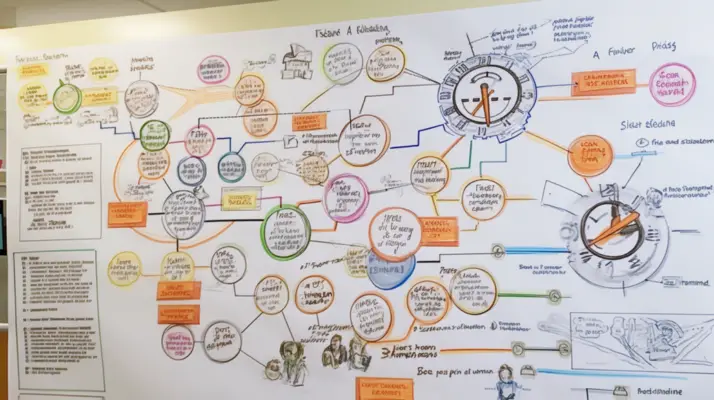Implementing Key Risk Indicators (KRIs) effectively is essential for proactively managing potential risks within an organization. Here are 13 tips to help you successfully implement KRIs:
- Understand your key objectives and risk categories to align KRIs with organizational goals.
- Engage stakeholders to gather diverse perspectives and insights on potential risk areas.
- Define risk factors that are specific, measurable, and relevant to your organization’s operations.
- Set thresholds or triggers for each KRI to establish clear boundaries for risk exposure.
- Avoid selecting a large number of KRIs that are too difficult to monitor or manage effectively.
- Integrate KRIs with Key Performance Indicators (KPIs) to track performance and risk simultaneously.
- Regularly review and update KRIs to ensure their relevance and effectiveness in capturing potential risks.
- Leverage technology and data analytics tools to automate KRI monitoring and reporting processes.
- Provide adequate training and resources to employees responsible for monitoring and acting on KRIs.
- Foster a culture of risk awareness and accountability across the organization to enhance KRI effectiveness.
- Establish a clear communication plan for sharing KRI insights and actions with relevant stakeholders.
- Conduct periodic risk assessments to validate the effectiveness of existing KRIs and identify new ones as needed.
- Continuously evaluate the impact of KRIs on risk management strategies and adjust them accordingly to improve effectiveness.
Organizations can strengthen risk management by implementing these tips. For further insights on implementing KRIs, you can refer to SafetyCulture and Certainty Software.
In today’s rapidly changing business landscape, effectively managing risks has become crucial for organizations. Key Risk Indicators (KRIs) play a vital role in identifying and monitoring potential threats to the achievement of organizational objectives.
However, implementing KRIs can be a complex process. This article provides 13 valuable tips to ensure the successful implementation of KRIs, helping organizations enhance their risk management practices and make informed decisions.

Overview of Risk Indicators
When it comes to managing risks, utilizing key risk indicators (KRIs) can provide numerous benefits.
These indicators offer organizations a proactive approach to identifying potential risks and taking timely actions to mitigate them.
Benefits of Utilizing Key Risk Indicators
Utilizing key risk indicators offers organizations valuable insights into potential risks and enables proactive risk management.
Key risk indicators (KRIs) are quantitative or qualitative metrics that help identify and measure potential risks within an organization. By implementing KRIs, organizations can better understand their risk profile and take necessary actions to mitigate potential threats.
The benefits of using KRIs are numerous. Firstly, they provide early warning signs, allowing organizations to identify and address risks before they escalate.
Secondly, KRIs enhance the effectiveness of risk management strategies by providing data-driven insights.
Moreover, KRIs enable organizations to prioritize and allocate resources to mitigate risks that are most critical to their operations.
Finally, KRIs can be integrated with key performance indicators (KPIs) to provide a holistic view of operational risks, further enhancing risk management efforts.
Understanding Your Risk Profile
To effectively understand your risk profile, it is essential first to identify and classify potential risks that your organization may face. This step allows you to understand the potential threats and vulnerabilities that could impact your business.
Once risks are identified, it is crucial to establish relevant performance metrics that can be used as key risk indicators to monitor and assess the level of risk exposure.
Identify and Classify Risks
To effectively understand your risk profile, it is important to identify and classify risks accurately. This step is crucial in developing a comprehensive risk management strategy.
The process of identifying and classifying risks involves evaluating your organization’s risk exposure and categorizing the types of risk it faces.
Creating a risk profile helps you better understand potential risks and their likelihood of occurring.
Proper risk identification also enables you to assess risk outcomes, prioritizing and allocating resources accordingly. Organizations can proactively address potential threats and develop appropriate risk mitigation strategies by identifying and classifying risks.
Establish Relevant Performance Metrics
One way to better understand your organization’s risk profile is by establishing relevant performance metrics. Performance metrics are measurements used to assess the effectiveness and efficiency of various processes within an organization. It is essential to establish appropriate performance metrics to implement key risk indicators (KRIs).
These metrics should align with your organization’s risk management objectives and provide meaningful insights into the potential risks and their impact on the organization.
Establishing relevant performance metrics allows for effective risk management.
Setting Up Your Risk Indicator Framework
When setting up your risk indicator framework, it is crucial to define the objectives of your KRI system to ensure alignment with your organization’s risk management goals.
Additionally, choosing the appropriate data sources and tools is essential for collecting accurate and relevant information to monitor risk exposure effectively.
Define the Objectives of Your KRI System
The first step in setting up your risk indicator framework is to define the objectives of your KRI system clearly. These objectives will guide your decision-making process and help you determine the appropriate measures to monitor and assess risks.
To ensure that your KRI system is in line with your organization’s goals and risk tolerance, it’s crucial to define your objectives.
This way, you can easily pinpoint and prioritize the most significant risks that can potentially affect your organization’s financial performance and expenses.
Furthermore, it will allow you to develop effective risk mitigation plans and take corrective action when necessary. The objectives should also encompass risk monitoring and provide insights into the potential impact of risks on the organization’s overall objectives.
Well-defined objectives make your KRI system a valuable tool for managing risks and making informed decisions.
Choose the Appropriate Data Sources and Tools
To effectively set up your risk indicator framework, carefully select the appropriate data sources and tools.
Choosing the right data sources is crucial for capturing relevant information about potential risks.
Consider collecting data from various sources such as internal systems, external databases, industry reports, and customer feedback.
These sources can provide valuable insights into the risk landscape and help identify emerging risks before they become significant issues.
Additionally, selecting suitable tools is essential for efficient data analysis and visualization. Depending on your organization’s needs, you may use tools like data analytics software, risk management platforms, or customized dashboards.
These tools can help automate data collection and analysis, enabling timely identification of key risk indicators and prompt action by the risk manager.
Adopting a data-driven approach and utilizing appropriate tools will enhance your risk management operations and enable proactive risk mitigation.
Monitor Risk Exposure in Real Time
Implement real-time monitoring of risk exposure to set up your risk indicator framework effectively. Monitoring risk in real-time allows organizations to identify and respond to potential risks promptly, minimizing the risk of loss resulting from compliance risks, reputational risks, future risks, and critical risks such as cyber risks.
Real-time monitoring also enhances the efficiency of risk management by providing up-to-date information for decision-making.
Organizations should establish a robust risk indicator framework to monitor risk exposure effectively. This framework should include key risk indicators (KRIs) that are aligned with the organization’s goals and objectives. KRIs should be measurable, actionable, and relevant to the specific risks being monitored.
Consider the following example of a risk indicator framework:
| Risk Category | Key Risk Indicators | Monitoring Frequency |
|---|---|---|
| Compliance Risks | Number of regulatory violations | Daily |
| Reputational Risks | Customer complaints | Weekly |
| Operational Risks | System downtime | Real-time |
| Cyber Risk | Number of security incidents | Hourly |
Implementing a KRI System in Your Organization
Implementing a KRI system in your organization requires the involvement of senior management and business unit leaders to ensure buy-in and support.
It is essential to develop a comprehensive risk monitoring strategy that covers all relevant areas and aligns with your organization’s goals and objectives.
Clear responsibilities for monitoring KRIs should be established to ensure accountability and compliance with regulatory requirements must be prioritized to mitigate legal and reputational risks.
Involve Senior Management and Business Unit Leaders
In order to effectively implement a KRI system in your organization, it is crucial to involve senior management and business unit leaders.
These individuals play a vital role in providing the necessary guidance and support throughout the implementation process.
Senior management brings a strategic perspective, understanding the organization’s overall objectives and risk appetite. On the other hand, business unit leaders possess specific knowledge about the operational context and associated risks.
Involving stakeholders ensures that the KRI system can be tailored to align with specific business unit needs and overall organizational goals.
Their input also helps identify relevant key risk indicators and establish appropriate thresholds.
Additionally, their buy-in and leadership in promoting the use of KRIs create a culture of risk awareness and accountability throughout the organization.
Develop a Comprehensive Risk Monitoring Strategy
To develop a comprehensive risk monitoring strategy for implementing a Key Risk Indicators (KRI) system in your organization, it is important to establish clear objectives and align them with the organization’s overall risk management goals.
This strategy should be designed to identify and monitor the key financial risks that your organization faces in order to mitigate the risk of loss arising from these risks.
It should also incorporate the use of KRI, which are specific metrics that provide early warning signals of potential risk events.
To help illustrate the components of a comprehensive risk monitoring strategy, the following table provides a visual representation:
| Components of a Comprehensive Risk Monitoring Strategy |
|---|
| 1. Clear Objectives |
| 2. Alignment with Risk Management Goals |
| 3. Identification and Monitoring of Key Financial Risks |
| 4. Integration with Business Continuity Plans |
| 5. Use of Key Risk Indicators (KRI) System |
Establish Clear Responsibilities for Monitoring KRIs
Responsibilities for monitoring Key Risk Indicators (KRIs) within an organization should be clearly established. In order to effectively monitor KRIs, it is important to assign clear responsibilities to individuals or teams within the organization.
Here are three sub-lists of tasks that can help establish clear responsibilities for monitoring KRIs:
- Identify and Define KRIs: This involves determining the specific KRIs that align with the organization’s strategic objectives and risk management framework. It requires a top-down approach, where the board of directors sets the overall direction and the risk management team identifies the individual risks and corresponding KRIs.
- Monitoring and Reporting: This includes regularly monitoring the identified KRIs, analyzing the data, and reporting the results to relevant stakeholders. It requires a bottom-up approach, where individuals responsible for specific assets or processes provide input and updates on the KRIs.
- Action Planning and Review: This involves developing an action plan based on the KRI results and regularly reviewing and updating the plan as needed. It requires collaboration between different teams and individuals to ensure that appropriate actions are taken to mitigate risks and improve performance.
Ensure Compliance with Regulatory Requirements
Organizations must ensure compliance with regulatory requirements when implementing a KRI system. Compliance efforts should be at the forefront of every decision made during implementation.
Preventive measures should be taken to identify and address potential issues before they become compliance risks. At the board level, decisive action should be taken to establish policies and procedures that align with regulatory requirements.
Response to regulatory changes should be swift and proactive, ensuring that the KRI system remains compliant. Training should be provided to employees to ensure they understand the importance of compliance and are equipped with the knowledge and skills to adhere to regulatory requirements.
Internal systems should be continuously monitored and updated to detect any deviations from compliance. By prioritizing compliance efforts, organizations can mitigate enterprise risks and avoid failures in risk management.

Evaluating KRI Performance and Taking Corrective Action
One important step in evaluating the performance of Key Risk Indicators (KRIs) and implementing corrective action is to conduct a thorough analysis of the data collected.
This analysis allows organizations to gain insights into the effectiveness of their KRIs and identify areas where improvements can be made.
To evaluate KRI performance effectively, consider the following tips:
- Define clear evaluation criteria: Establish specific metrics and benchmarks to assess KRI performance objectively.
- Regularly review and update KRIs: Ensure that the selected indicators remain contextually relevant and aligned with the organization’s risk profile.
- Utilize data visualization tools: Present KRI data in a visually appealing and easy-to-understand format for better analysis and decision-making.
Frequently Asked Questions
How Can I Identify the Most Important Risk Indicators for My Organization?
To identify the most important risk indicators for your organization, it is crucial to understand your business’s specific risks and objectives.
Conduct a comprehensive risk assessment to determine the key areas that require monitoring and establish relevant and measurable indicators.
What Are the Common Challenges Faced While Implementing Key Risk Indicators?
Common challenges faced while implementing key risk indicators include lack of clear objectives, inadequate data quality, resistance to change, and difficulty in selecting relevant indicators.
Overcoming these challenges requires proper planning, stakeholder engagement, and continuous monitoring and evaluation.
Are There Any Best Practices for Monitoring and Reporting Key Risk Indicators?
Best practices for monitoring and reporting key risk indicators include defining clear objectives, establishing relevant metrics, ensuring data accuracy and consistency, implementing a robust reporting framework, and regularly analyzing and reviewing the indicators to drive effective risk management.
How Can I Ensure That the Data Used for Calculating Key Risk Indicators Is Accurate and Reliable?
Organizations should establish robust data governance processes, conduct regular data quality assessments, and implement strong data validation and verification mechanisms to ensure the accuracy and reliability of data used for calculating key risk indicators.
What Steps Should Be Taken to Continually Improve the Effectiveness of the KRI System in an Organization?
To continually improve the effectiveness of the KRI system in an organization, it is important to regularly review and update the KRI framework, ensure alignment with business objectives, conduct risk assessments, monitor KRI data, and communicate findings to key stakeholders.

Conclusion
Effective implementation of key risk indicators requires understanding the organizational risk profile and setting up a robust framework.
It is crucial to regularly evaluate the performance of these indicators and take appropriate corrective actions when necessary.
Organizations can improve risk management and make informed decisions.

Chris Ekai is a Risk Management expert with over 10 years of experience in the field. He has a Master’s(MSc) degree in Risk Management from University of Portsmouth and is a CPA and Finance professional. He currently works as a Content Manager at Risk Publishing, writing about Enterprise Risk Management, Business Continuity Management and Project Management.

